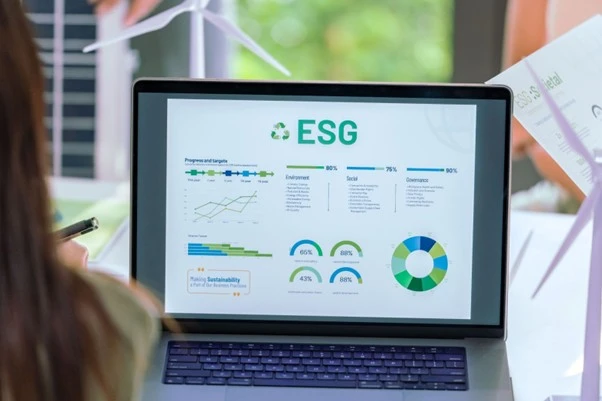
Introduction:
According to a source, the current ESG market is estimated to be worth 7.02 trillion USD, with significant investment growth in green bonds across numerous countries. In 2025, ESG criteria are poised to become an integral part of standard business practices.
ESG compliance is crucial for all entities across industries to build trust with stakeholders and attract investors. It serves as a fundamental parameter for transparent ESG reporting. This article explores the concept of ESG compliance, including reporting requirements, compliance software, ESG checklists, and relevant frameworks.
What is meant by ESG Compliance?
The source highlights a concerning trend: 40% of global entities have failed to meet their ESG requirements, while 30% are struggling to adapt to evolving regulations, particularly in complex regions like Europe.
This data implies a significant gap between the growing importance of ESG and the actual level of compliance among organizations.
ESG compliance encompasses adhering to accepted environmental, social, and governance principles, legislation, and frameworks specific to a particular region or industry. It involves integrating these principles into a company's operations and demonstrating compliance through transparent reporting.
When implementing ESG compliance within an organization, performance measurement across three key areas is essential:

Those areas are:
- Environmental:
- Environmental performance measures the extent to which an organization's business activities impact the environment.
- Key environmental impacts include various emissions (including greenhouse gas emissions), chemical releases, energy consumption, and waste management.
- In 2024, several new environmental metrics were introduced, including:
- Enhanced Corporate Disclosures.
- The potential inclusion of the Global Plastics Treaty within environmental considerations.
- Double Materiality (considering both the impact of the environment on the business and the impact of the business on the environment).
- Social:
- Social criteria emphasize fostering positive relationships with employees, customers, stakeholders, and suppliers.
- This includes promoting workplace equality, upholding gender rights, prioritizing employee well-being, and ensuring social responsibility throughout the supply chain.
- Governance:
- This encompasses strong corporate governance practices, including:
- Ethical leadership and board oversight.
- Transparent and accountable decision-making processes.
- Robust internal controls and risk management systems.
- Fair and equitable treatment of all stakeholders.
- Compliance with relevant laws and regulations.
- This encompasses strong corporate governance practices, including:
ESG Compliance Frameworks:
ESG compliance frameworks provide principles or guidelines that assist organizations, individuals, and investors in aligning their practices with environmental, social, and governance considerations. These frameworks offer a structured approach to addressing ESG issues within business operations and measuring performance through reporting.
Common compliance frameworks used by organizations and investors include:
- Global Reporting Initiative (GRI) Framework:
- Focuses on providing a comprehensive framework for sustainability reporting.
- Covers a wide range of ESG topics.
- Aims to improve decision-making and enhance risk management.
- Sustainability Accounting Standards Board (SASB) Framework:
- Focuses on industry-specific ESG issues, considering the unique challenges and opportunities faced by different sectors.
- Provides valuable guidance for investors.
- Integrated Reporting Framework:
- Emphasizes a holistic approach to reporting, integrating financial and non-financial information to provide a more comprehensive view of organizational performance.
- Provides valuable guidance for investors.
- Carbon Disclosure Project (CDP) Framework:
- Helps organizations measure and disclose their environmental impacts, particularly focusing on climate change.
- Provides valuable guidance for investors.
It's important to note that the specific frameworks used may vary based on geographic location, industry-specific requirements, and organizational priorities.
ESG Compliance Requirements

ESG Compliance Checklist
1. Define Organizational Goals:
- Each organization's business goals are unique based on its industry. Clearly define your organization's ESG purpose.
- For example, some organizations may prioritize reducing their carbon footprint, while others may focus on attracting investors
- Establish clear and specific ESG goals before embarking on the compliance journey.
2. Choose the Right ESG Compliance Frameworks:
- Each framework offers distinct metrics and covers different areas of focus.
- ESG frameworks provide a comprehensive roadmap for preparing ESG reports.
- Select the frameworks that best align with your organization's specific goals and industry requirements.
3. Environmental Compliance Checklist:
- If carbon emission reduction is a key goal, ensure the following:
- Measure Scope 1, 2, and 3 emissions accurately.
- Ensure data credibility by integrating your business with reliable ESG data management software like Updapt.
- Set ambitious and achievable emission reduction targets at each phase.
- Monitor water consumption and implement measures to reduce water usage.
- Reduce and recycle waste materials effectively.
4. Social Compliance Checklist:
- Provide necessary training to employees on social and ethical issues.
- Prevent child labor practices and ensure their absence throughout the supply chain.
- Adhere to all relevant labor laws, including those related to working hours and wages.
- Maintain a safe and healthy working environment with adequate facilities.
- Implement and enforce energy conservation protocols.
5. Governance Checklist:
- Maintain strict data privacy and security policies to prevent breaches.
- Implement and enforce a robust anti-corruption policy.
- Engage regularly with investors and other stakeholders to build trust and transparency.
- Adhere to all relevant regional and national regulations.
- Ensure transparency in ESG reporting.
6. ESG Risk Assessment:
- Legal risks (e.g., non-compliance with regulations)
- Physical risks (e.g., climate change impacts)
- Supply chain risks (e.g., social and environmental issues within the supply chain)
- Investor risks (e.g., reputational damage, divestment)
- Data privacy risks.
7. Evaluate ESG Performance:
- Regularly measure and evaluate ESG performance to track progress and identify areas for improvement.
- Analyze the gap between actual performance and established goals.
- Identify opportunities to enhance ESG performance.
- Track trends and patterns over time.
- Benchmark performance against industry peers.
What is Meant by ESG Compliance Reporting?

ESG compliance reporting provides a structured framework for organizations to communicate their ESG performance to stakeholders. It involves measuring and reporting on an organization's environmental, social, and governance practices.
ESG Compliance Solutions with Updapt ESG Compliance Software
Data Management:
- Effectively managing ESG data is crucial for enhancing ESG reporting.
- Updapt ESG data management software collects ESG data from various sources, including third-party applications, and ensures data credibility and accuracy.
- It consolidates all collected ESG data within a centralized data repository with Data analysis.
Framework Selection:
- Frameworks may vary based on industry requirements and organizational goals.
- Updapt compliance software leverages its understanding of business behavior to recommend the most suitable frameworks for each organization.
Addressing Challenges:Updapt ESG compliance Software:
- Updapt addresses the challenges of data collection, data quality, and framework selection by:
- Collecting data from diverse sources and ensuring data accuracy.
- Providing guidance on selecting the most appropriate ESG frameworks based on individual organizational needs.
- Streamlining data management processes to improve efficiency and reduce the burden on organizations.
To sum up
ESG compliance is no longer a mere trend; it's a critical factor for long-term business success. With the increasing emphasis on sustainability and the growing influence of ESG investors, organizations that prioritize ESG integration will gain a competitive advantage.
By implementing robust ESG data management strategies, leveraging tools like Updapt, and adhering to relevant frameworks, organizations can effectively navigate the evolving ESG landscape, mitigate risks, and build a more sustainable and resilient future.
Faq
What is ESG compliance?
ESG compliance is nothing but pursuit of the Enviormatal, social and governance guidelines.
What is the ESG compliance process?
ESG compliance process implies a way to execute the environmental, social and governance practise in a duly way that includes ESG frameworks selection, choosing the right ESG frameworks, better esg data management, ESG requirement and best practices.
ESG Risk and Compliance
Each organization has been adhering to different ESG compliance based on their ESG goal and ESG objective. In that, ESG Risk and Compliance represent the process of identifying, managing, and mitigating the risk in business operations. Whereas, it also includes whether organizations adhere to right esg regulation and standard, choose esg frameworks or not.
Who should comply with ESG?
ESG is almost necessary for all companies. So, every industry of organizations should comply with ESG.
What are ESG regulations?
It represents guidelines on how organizations develop Environmental, social and governance reports.
Is ESG compulsory?
Yes, ESG is almost compulsory for all industry companies and all countries.
What is ESG stand for?
It stands for Environmental, social and governance.
What are the criteria for ESG compliance?
Environmental, social and governance based compliance requirements and based on country specific regulations.
What is the full form of ESG audit?
Environmental, social and governance audit.

